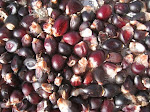 Since we're rather sparse in the greens category this fall, thanks to the extremely hot and dry August, we are bringing up more roots, including Japanese turnips, daikon, and burdock.
Since we're rather sparse in the greens category this fall, thanks to the extremely hot and dry August, we are bringing up more roots, including Japanese turnips, daikon, and burdock.The long tap root of the burdock plant goes down about 3 feet. You cannot pull them as you would a beet or radish, but must dig down alongside them, loosen them, and gently lift them out. Although most burdock roots are straight, every now and then, you'll see an intertwined pair of roots like these that our intern Charlie just extricated here.
Burdock root definitely falls into the “can’t judge a book . . .” category of vegetables. At the market we sometimes wish that burdock were red or yellow and shiny like a colored pepper to attract the human eye. Alas, burdock is dull and brown and looks tough and unappetizing. But it is tender (you can scrape away the thin skin with a light fingernail) and earthy and delicious. It is also low in calories and high in fiber, iron, and inulin, a carbohydrate that is good for diabetics. The humble exterior of the large, dark, woody-looking root belies the sweet, nutty, delicate, crunchy flesh within.
Henry and I first encountered burdock as a food on our separate sojourns in Japan during the 1980s. Although the plant grows throughout Europe and North America, until very recently it had been cultivated only in Japan. Only now are we rediscovering what many Native Americans knew about the virtues of burdock. For the Illiniwek, burdock was an important winter food. They dug it in the fall, under the Harvest and Hunter’s Moons, and dried it. Then they ate it throughout the long, cold months of winter.
In addition to being used as a food item for millennia, many cultures have used burdock medicinally. Early Chinese physicians treated colds, flu, throat infections, and pneumonia with burdock preparations, and it is considered a powerful source of “yang” energy according to Chinese philosophy and macrobiotic practice—meaning it gives you the energy and strength to do what needs to be done.
As I mentioned, we're a bit low on fall salad greens this year, but look for some lovely mizuna bunches (the frilly, saw-toothed leaves above) and mesclun mix (using some of our buttery lettuces like the one below) coming to the Evanston Market this Saturday.





No comments:
Post a Comment